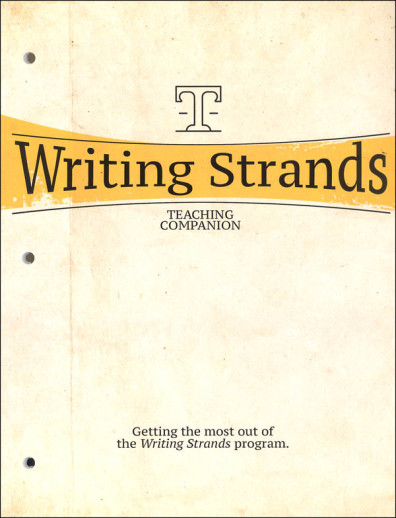We use cookies to make your experience better. To comply with the new e-Privacy directive, we need to ask for your consent to set the cookies. Learn more.
Writing Strands (Teaching Companion)
The Teaching Companion is a writing/literature resource for the program.
Provides helpful guidance for anyone using the Writing Strands curriculum!
Teachers will find this an invaluable resource, not only for using the Writing Strands curriculum but also for teaching any course that includes writing and literature as a component. The Teaching Companion provides a helpful overview of the Writing Strands system, as well as additional information on a range of writing, grammar, and literature issues that a teacher may face at any level of the program.
- Provides discussion of the most common difficulties that students encounter, as well as tips on how to help students overcome these challenges
- Offers suggested goals and objectives for teaching literature, broken down by age range
- Includes appendices with information on basic citation, advice on teaching vocabulary, commonly confused words, and glossaries of grammar and literary terms.
We highly recommend that teachers read the Teaching Companion before their students start the course and that they continue to consult it as needed as students learn additional concepts.
Writing Strands, long a homeschooling favorite, has received an expansion and facelift from its new publisher, Master Books. Still providing the same quality, step-by-step writing instruction, the major difference is that there is MORE than just writing instruction. A complete series of reading/literature lessons is interwoven with the writing instruction resulting in solid language arts courses. Each consumable worktext provides space to complete the writing assignments as well as worksheets for discussing books (chosen and assigned by teacher/parent) and Bible passages. The student is encouraged to keep an ongoing spelling list as well as constantly be involved in the writing evaluation process. Composition lessons cover the writing process and provide experience with the various forms of writing as well as specific traits of good writing. Reading/literature lessons provide literary analysis instruction coupled with discussion questions and biblical applications.
All instruction is provided in the Student Worktexts. Students are encouraged to build a portfolio binder although there is ample space provided to complete many of the Worktext assignments. Introductory information includes course descriptions/principles, writing guidelines, skills writing mastery chart, list of problems to solve (this is kept as a running list based on assignment completion), and a detailed daily schedule. Detailed lessons, written directly to the student, are provided for 180 days (five days a week; four 9-week quarters) and can be expected to take 30-45 minutes to complete. Bible passages are used as the primary resource for the literary analysis lessons. These lessons are coupled with book studies using literature selections chosen by the parent. Answer keys for objective portions are included as well as a glossary of helpful terms.
This edition is a bit more grade specific than the previous version although there is still some flexibility. Each level is a one-year course. Typically students would begin the series in 5th grade and progress through 10th but a student with good reading skills could start in 4th (possibly, 3rd). An older student (ex. 7th grade) would typically start with Intermediate 1 but could start with a lower level if their writing skills are minimal. Students should be able to enter at grade level assuming they are reading at or above grade level. Grammar and spelling are covered from a usage perspective so you may want to add a grammar and/or spelling workbook for practice and basic instruction. All course books are three-hole punched. ~ Janice
| Product Format: | Paperback |
|---|---|
| Grade: | AD |
| Brand: | Master Book Publishers |
| ISBN: | 9781683440932 |
| Length in Inches: | 10.875 |
| Width in Inches: | 8.375 |
| Height in Inches: | 0.1875 |
| Weight in Pounds: | 0.4 |
Be the first to review this item


I will be using Writing Strands Beginning 1 and 2 for the first time.
Recommended by The Well Trained Mind
This teacher companion seems to be a great foundation for writing, spelling rules, and how to encourage young writers when problems occur.
I have Writing Strands but this was recommended, even if not using WS.